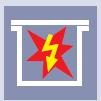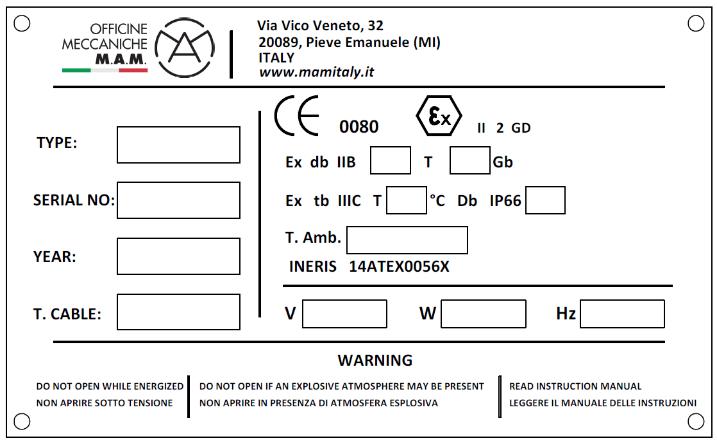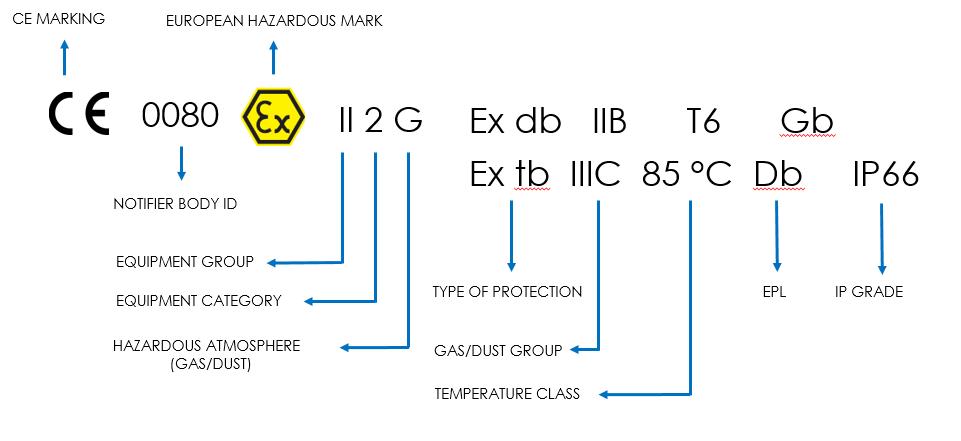

1. GENERAL INFORMATION
Atex is the acronym of Atmosphere Explosive, explosive atmosphere, that is a mixture of flammable substances in form of gas, vapours, mist or dust, where combustion, after ignition, propagates through all the flammable mixture.
A potentially explosive atmosphere is an atmosphere that is not explosive under normal operating condition, but can become such in case of unpredictable events, like gas leaks, equipment failure, temperature or pressure
To obtain the formation of an explosive atmosphere it is necessary that flammable substances are present in a determined concentration, otherwise a reaction of combustion will take place only or no reaction at all. This concentration range is defined for each flammable substance by the lower explosion limit (LEL) and the upper explosion limit (UEL), that is the minimum and maximum concentration, between which a given substance may be ignited, when given an ignition source.
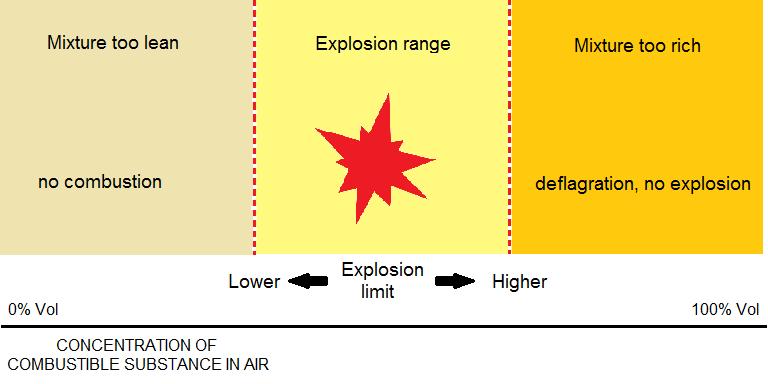
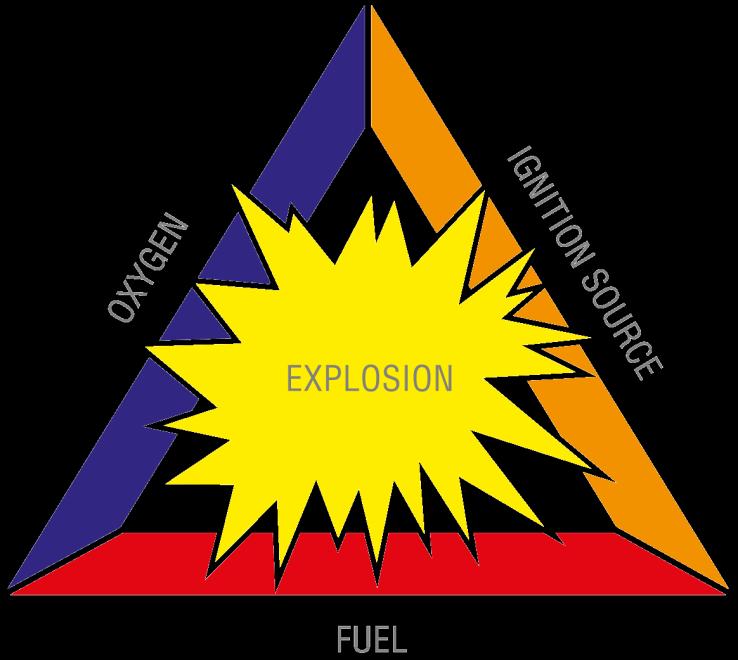

2. REGULATION IN FORCE

Explosive atmospheres can arise in several industrial fields (oil&gas, chemistry, pharmaceutical, feed industry, metallurgic) during transport, manufacturing or storage processes and if ignited they can lead to harmful or catastrophic events for people and the environment. ATEX directive, in the European Union countries, aims to uniform the different legislationsof its memberswith respect to the risk given by the presence of potentially explosive atmosphere: it is divided in 2014/34/UE and ATEX 99/92/CE.
ATEX directive 2014/34/UE defines the essential safety requirements and protection systems intended to be used in potentially explosive atmosphere. It applies for manufacturers and require the certification of their products.
ATEX directive 99/92/CE defines the minimum requirements for safety and health in working environments in potentially explosive atmospheres, where plants and certificated equipmentareemployed.Itappliesforfinalusers.
IECEx Certification

TheATEXcomplianceismandatoryinUEcountries for equipment installed in explosive atmospheres. At international level instead it is widespread the IECEx certification, that is a certification scheme that testifies conformity to Ex standard (issued by IEC – International Electrotechnical Commission) for electrical equipment. IECEx certification was derived from representatives, industries and laboratories with the common aim to ease the international commerce of Ex equipment, ensuringtherequiredsafetylevelsandavoidingto pass conformity tests for each single market. A list of countries that currently accept the IECEx certification are reported in the table below.
Ex-TR-CU Certification

To trade Ex products in theDoganal Union formed by Russia, Armenia, Kirghizistan and Kazakistan it is mandatory the Ex-TR-CU certification.


3.1 GROUPS AND CATEGORIES
According to ATEX directive, products are divided into categories based on the level of protection required and depending on the degree of danger of the environment I which they will be installed.
Group I: equipment intended for use in mines above and below ground. It is divided into two categories depending on the required protection level.
M1: equipment in this category is required to remain functional with an explosive atmosphere present. Level of protection “very high”
M2:thisequipmentisintendedtobede-energised in the event of an explosive atmosphere forming.
Level of protection “high”.
Group II: : equipment intended forusein location, other than mines (surface industries). It is divided into three categories depending on the required protection level. For gaseous atmosphere categories are identified by the letter G, while for dusty atmospheres by the letter D.
1G o 1D: an explosive atmosphere is present continuously or for long periods. Level of protection “very high”.
2G o 2D: an explosive atmosphere is occasionally present. Level of protection “high”
3G o 3D: an explosive atmosphere is not likely to occur of if it does, it will be only for short periods.
Level of protection “normal”.
All electric equipment falling in categories 1 and 2 must be certified by an ATEX notified body and manufacturing companies have to undertake a quality surveillance system. For equipment falling in category 3, an auto-certification is sufficient. All product, whichever their group or category, must be CE certified and must be provided with the instruction manual.
3.2 DEGREE OF PROTECTION EPL
At international level, the Equipment Protection Level EPL was introduced in 2007 for the equipment classification. EPLs identify products according to the explosion risk they can cause, easing in this way the risk evaluation and component selection.
EPL Ma: equipment for installation in mines with level of protection “very high”: no risk of ignition in case of predictable or rare malfunctions during normal operation, even in case of gas leaks.
EPL Mb: equipment for installation in mines with level of protection “high”: no risk of ignition in case of predictable malfunctions during normal operation, even during the period between a gas leak and shut down.
EPL Ga or Da: equipment for installation in explosive atmosphere with level of protection “very high”: no risk of ignition in case of predictable or rare malfunctions during normal operation.
EPL Gb or Db: equipment for installation in explosive atmosphere with level of protection “high”: no risk of ignition in case of predictable or rare malfunctions during normal operation.
EPL Gc or Dc: equipment for installation in explosive atmosphere with level of protection “augmented”: no risk of ignition during normal operation. Additional protection measures are implemented to ensure equipment to remain inactiveasignitionsourcein caseof predictableor rare malfunctions.

3.3 ZONES CLASSIFICATION
According to ATEX 99/92/CE, explosive atmosphere are divided in zones by the employer by applying EN 60079-10.
Zona 0: an explosive atmosphere consisting of a mixture of air and flammable substances in form of gas, vapours or mists is present continuously or for long periods.
Zona 20: an explosive atmosphere consisting of a mixture of air and flammable substances in form of dusts is present continuously or for long periods.
Zona 1: an explosive atmosphere consisting of a mixture of air and flammable substances in form of gas, vapours or mists is occasionally present under normal operating conditions.
Zona 21: an explosive atmosphere consisting of a mixture of air and flammable substances in form of dusts is occasionally present under normal operating conditions.
Zona 2: an explosive atmosphere consisting of a mixture of air and flammable substances in form of gas, vapours or mists is never present, or if it occurs, it will be only for short periods.
Zona 22: an explosive atmosphere consisting of a mixture of air and flammable substances in form of dusts is never present, or if it occurs, it will be only for short periods.
The correspondence between EPL and ATEX categories in their respective installation zones is shown in the table below. Next figure shows instead an example of zones subdivision.


3.4 ATMOSPHERE GROUPS
The choice of the equipment is to be made according to the zone it will be installed into, the present substances and their ignition temperatures. Electric equipment of group II are divided into subgroups IIA, IIB and IIC for gas and IIIA, IIIB and IIIC for dust.
Group C is more restrictive than group B, that in turns in more restrictive than group A in terms of danger and safety regulation. Therefore, equipment designed for group IIC or IIIC can be used for application IIB or IIIB but not vice versa.


3.5 TEMPERATURE CLASS
The ignition temperature of the substances constituting the explosive atmosphere is another fundamental aspect to be considered. This value, defined as the lowest temperature at which an explosive mixture ignites spontaneously, must be
higher than the maximum superficial temperature of the different components.
For gas, electric components are divided into 6 temperature classes from T1 to T6 according to the limits reported in table

Component classified as T3 may be used in zones, whichrequireT1orT2,butacomponentclassified as T4 must notbe used in zones,which requireT5.
In the following table some examples of most commonly used substances in ATEX sectors are reported.
For combustible dusts a distinction is mad between clouds and layers of dusts. In case of cloud of dust with ignition temperature ������, regulation states that the highest superficial temperature must be �� ≤2/3 ������
Dusts
In case of layer of dust instead, the higest permissible temperature is �� =��5���� 75°�� (there are special table to evaluate the highest temperature for layers of dust thicker than 5mm).


